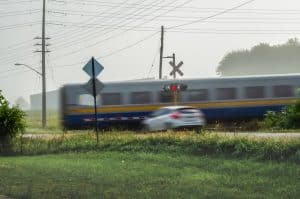Train/Car Collisions Have Deadly Consequences
 When a road intersects with a railroad track at the same level, this is known as a grade (or level) crossing. Before legislation passed during the 1990s to make grade crossings safer, most railroad accidents happened at these spots when cars attempted to drive over the tracks, only to collide with a train. Although more injuries and fatalities now occur when trespassers try to cross railroad tracks where there is no crossing, grade crossing accidents are still a significant danger for motorists.
When a road intersects with a railroad track at the same level, this is known as a grade (or level) crossing. Before legislation passed during the 1990s to make grade crossings safer, most railroad accidents happened at these spots when cars attempted to drive over the tracks, only to collide with a train. Although more injuries and fatalities now occur when trespassers try to cross railroad tracks where there is no crossing, grade crossing accidents are still a significant danger for motorists.
Most collisions between trains and automobiles happen when trains travel under 35 miles per hour during daylight hours in crossings with automatic warning devices. Unfortunately, train accidents often result in severe injuries and numerous fatalities. Here are some facts:
- The average weight of a train is 12 million pounds, making the weight ratio of a train to an automobile about 4,000 to one – comparable to the weight of a car versus an aluminum can.
- A motorist involved in a train/car collision is 40 times more likely to die than someone involved in an accident between two motor vehicles.
- A train pulling 100 cars traveling 50 mph takes one mile to come to a stop.
According to Federal Railroad Administration statistics, 2,145 railroad crossing collisions occurred in the U.S. in 2021, resulting in 234 fatalities and 669 injuries. Georgia ranked third in the number of highway-railroad crossing accidents (behind Texas and California) with 132 collisions, eight deaths, and 37 injuries.
Proving negligence for a railroad crossing accident
If an injury occurred at a railroad crossing because a railroad company did not provide adequate training, equipment, or safe conditions, the company could be held liable for failing to keep the public safe. When you bring a lawsuit seeking monetary compensation for an injury, you will need to prove that another party or entity was negligent and their negligence caused you to be injured.
Some examples of railroad negligence include:
- Using faulty equipment
- Failing to provide a safe environment
- Failing to train employees adequately
- Not performing frequent inspections
- Improper maintenance of trains or equipment
- Failing to mark or maintain a railroad crossing properly
To prove fault and receive monetary compensation for their damages, an injured person must properly document their injuries. Some examples of evidence that can be valuable in establishing a plaintiff’s case in a railroad crossing accident include the following:
- Accident reports filed by law enforcement or first responders
- Dispatch records that document train movement
- Government reports from the National Transportation Safety Board (NTSB), Federal Railroad Administration (FRA), the Occupational Safety and Health Administration (OSHA), or the Environmental Protection Agency (EPA)
- Medical records and bills concerning accident-related treatment
- Photographs of the accident scene that highlight steep or unlevel crossing conditions that may have contributed to the accident and the damage sustained
- Video footage from the train that may have recorded what happened
- Data from the train’s Event Data Recorder (EDR) that recorded the train’s operations at the time of the accident
- Maintenance records pertaining to the train, tracks, and grade crossing
- Contact information for anyone who might have witnessed the collision
The more information that can be gathered, the stronger the case will likely be.
How to avoid a collision at a railroad crossing
There are numerous ways drivers and pedestrians can avoid colliding with a train at a railroad crossing, such as:
- Always slow down when approaching a railroad crossing and look both ways before proceeding.
- Never try to race a train across the tracks.
- Avoid passing another vehicle within 100 feet of a railroad crossing.
- Look out for vehicles that are required to stop at railroad crossings, including school buses or cargo vehicles carrying hazardous materials.
- When approaching a crossing, turn off your radio or air conditioner and roll down your window so you can hear whistles or bells.
- Yield to flashing lights, whistles, gates that are closing, crossbucks, or stop signs.
- Downshift before you reach a railroad crossing, not while in the middle of one.
The experienced personal injury attorneys at Harris Lowry Manton have handled cases involving deadly collisions with trains. In 2017, our firm secured an $11.2 million verdict on behalf of the parents of Sarah Elizabeth Jones, a camera assistant on the film Midnight Rider, who was struck and killed by a CSX train on the first day of filming.
If you or someone you love sustained serious injuries in a railroad crossing accident, Harris Lowry Manton will work to hold the negligent parties accountable. Call us in Atlanta or Savannah, or fill out our contact form to schedule your free initial consultation today.
Related Articles
- What Are the Leading Causes of Train Accidents in Savannah?
- Over 50 Injured, Three Killed in Amtrak Train Derailment
- Human Error Is the Most Common Cause of Train Accidents
- CSX Owned and Operated the Tracks in the Fatal Collision with the Amtrak Train on Sunday
- What Are Grade Crossing Railroad Accidents?
- Savannah Train Accident Lawyer
- Train Accident Attorneys in Atlanta

Jed Manton is committed to representing individuals and business that have been harmed by the actions of others. With a solid track record, Jed has helped numerous clients who have been seriously injured or who have lost a loved one obtain justice, while holding the wrongdoer accountable.
Read more about Jed D. Manton here.
